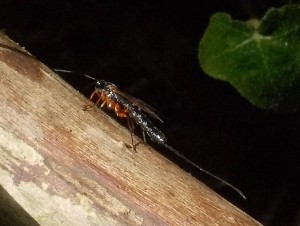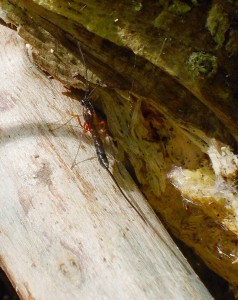A terrifying monster stalks the suburbs. Silently and with unerring accuracy, it scans the surface, using its advanced sensors to detect and identify targets buried deep below. Once a target has been located, the hunter drills down to find it, deposits the payload, and leaves in search of the next. It could be a cyber-borg or pilotless military vehicle. Actually, it’s Rhyssa persuasoria, the giant Ichneumon. And giant or not, it’s about 30mm long.

Rhyssa is a parasitic wasp, a solitary hunter distantly related to the social, black-and-yellow striped wasps. Her prey are the larvae of other insects which burrow in dead wood for food and safety. Only when she is above, safety below is hard to find. For Rhyssa‘s weapon is as long as her body: her ovipositor is greatly elongated into a precision instrument that can drill deeply through wood and into the body of the larva. Once there, she lays a single egg down the ovipositor tube. The egg hatches inside the still-living larva, and devours it from the inside. The larva dies (so Rhyssa is a parasitoid, not a true parasite that avoids killing its host) and a young Ichneumon emerges.

Today at Gunnersbury Triangle we erected a new bench, to allow visitors to relax and enjoy a quiet moment in nature. It sounds a trivial task. If only. Two volunteers spent a day putting the “ready to assemble” kits together. All the supplied bolts were the wrong size, so they had to ream out all the pre-drilled holes to the larger size. Meanwhile, that day, I dug out the well-embedded MetPosts remaining from a previous bench. Then we dug 2 holes for the new bench: they promptly filled up with water, and the deeper we dug, the more the local weakly-cemented gravel (our local rock, when it isn’t sticky clay) collapsed into the hole, making it wider at the bottom. It was clearly hopeless.
So today we spent an hour prospecting for a drier place that would also be aesthetically pleasing, not harm the rare ferns nor disturb the nesting Blackcaps, and be close to an existing path. Then we started digging holes all over again. This time they didn’t fill up with water, much: just the bottom 10 cm or so. To keep the sides from crumbling, we avoided digging with spades: we lay on bin-bags, and wearing rubberised gardening gloves, scooped out handfuls of wet gravel. Then we levelled the two holes, cast a base of PostCrete in each, let it cure — at this point everybody disappeared for a cup of tea, leaving me in the wood guarding the site. I sat on a coppiced Willow trunk, and was approached by the giant Ichneumon when I least expected it. Luckily my little camera was not far away — you can readily imagine why I wouldn’t want the big camera with me while working.
The team reassembled, we gingerly lowered the bolted wooden creation into place, wedged it tight with broken bricks, and fixed it in place with plentiful PostCrete before cunningly sloping the top to shed rainwater. Needless to say, during this procedure we accumulated more and more tools all round the excavation site. If only it were as simple as drilling for an unseen caterpillar and laying an egg in it. But then, Rhyssa has the jump on us, with millions of years of evolution in her hunting technique.
